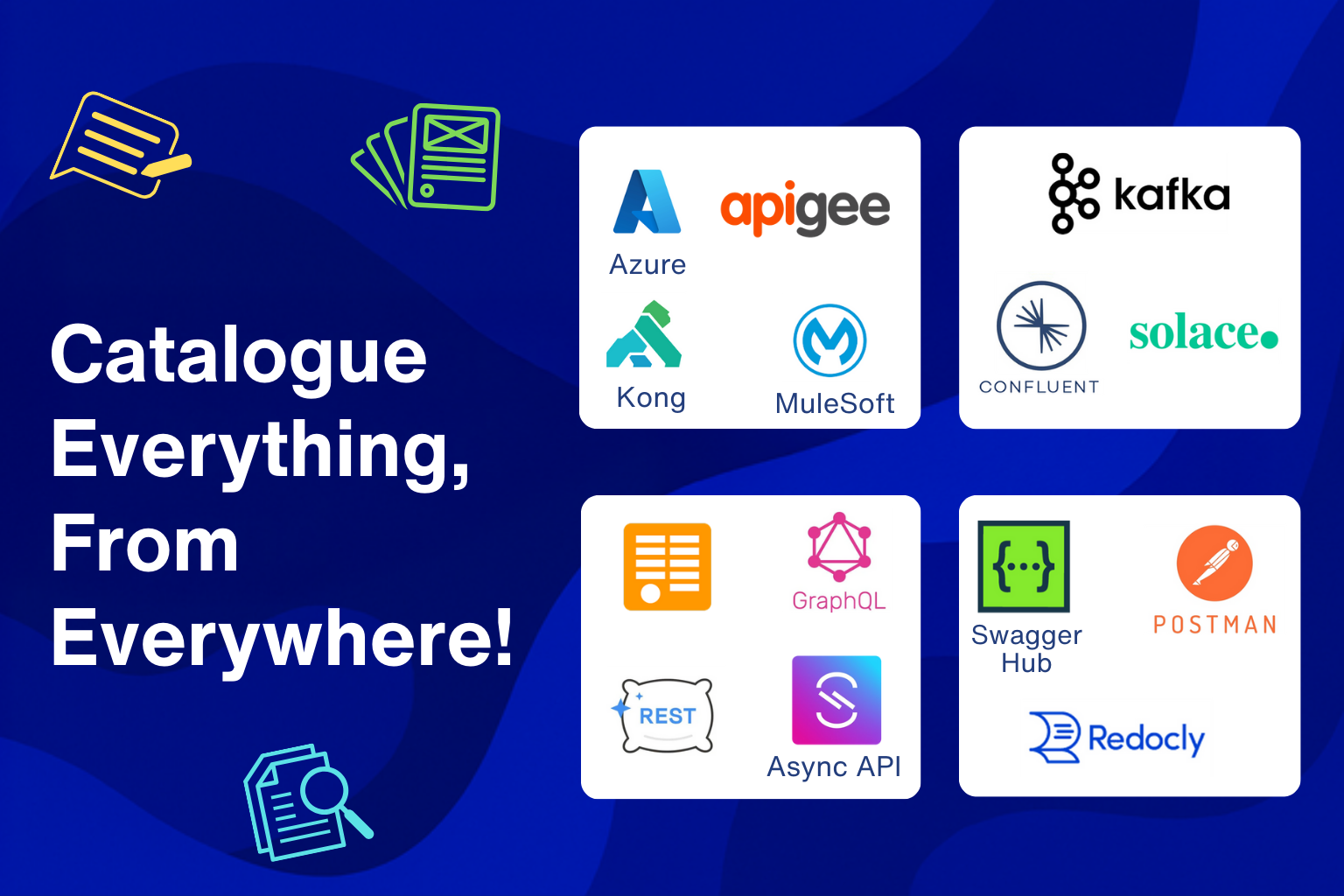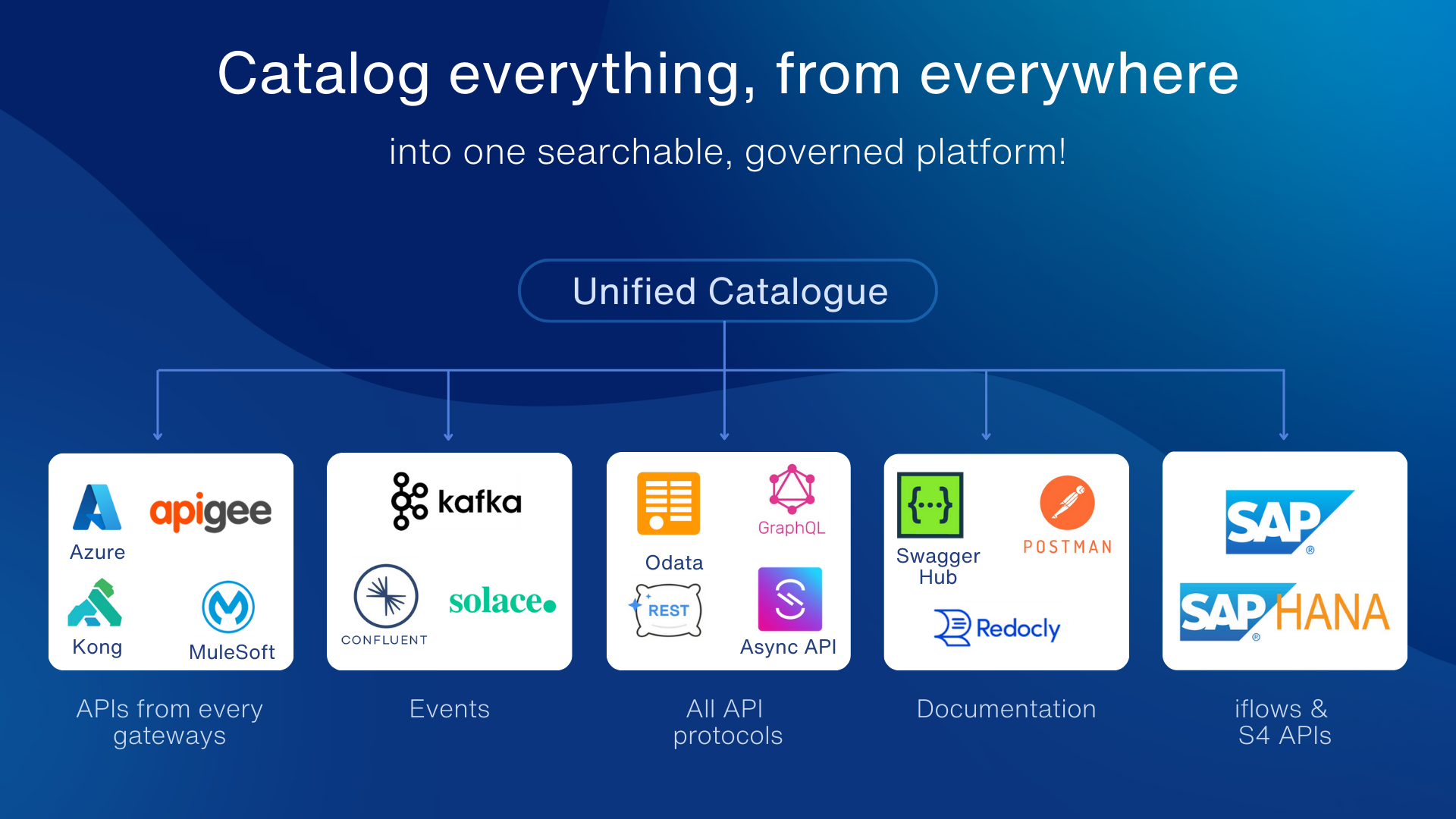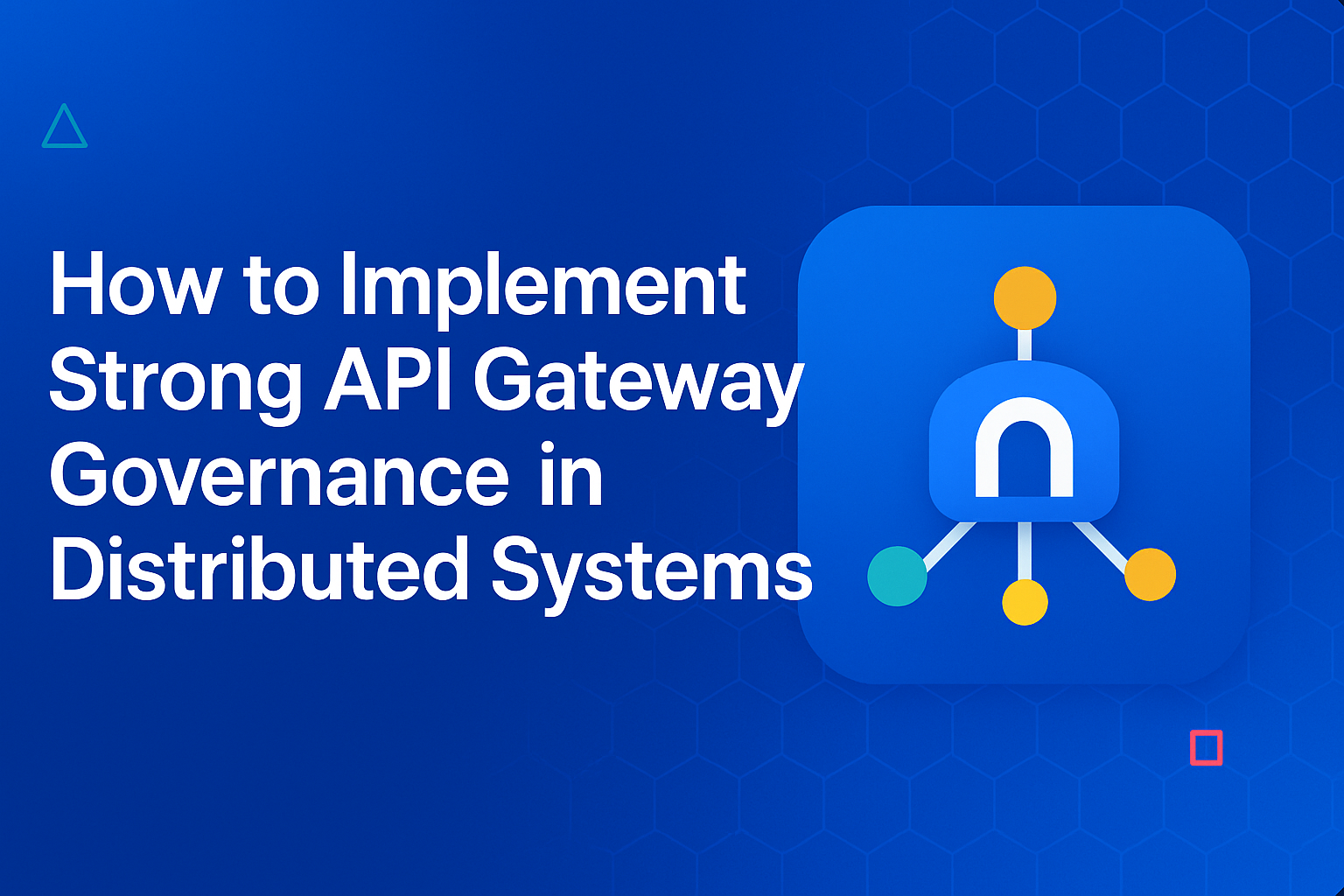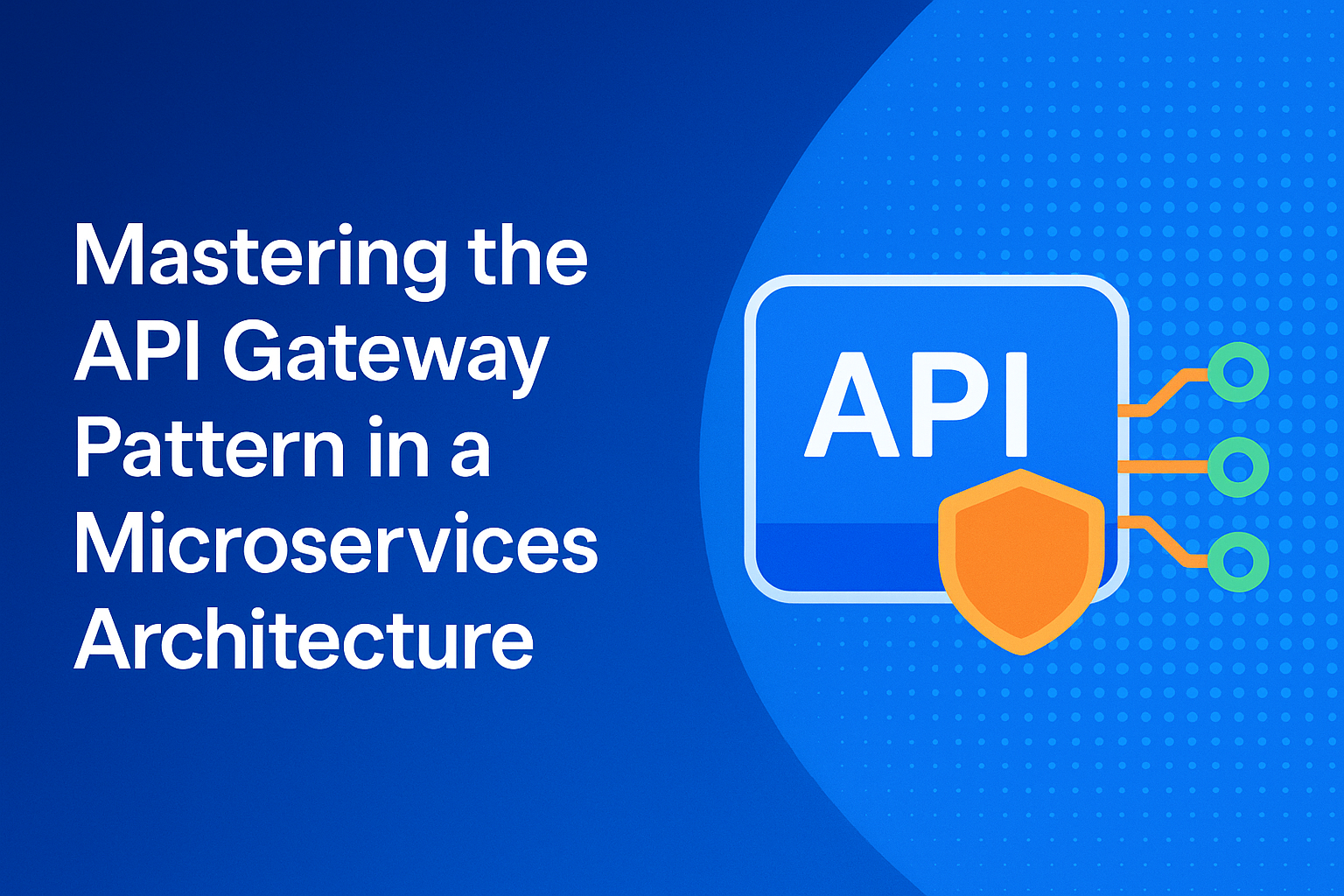Blog
How to catalogue APIs, events & documentation from multiple gateways and cloud platforms in one place
Updated on:

APIs, events, and documentation often get scattered across different gateways, brokers, and platformscreating silos that slow down discovery, reuse, and governance. This blog explains why centralising them in a single catalogue is key to streamlining visibility and control.
A unified catalogue brings together APIs from Apigee, Kong, MuleSoft, and Azure; events from Kafka, Solace, and Confluent; and docs from SwaggerHub, Postman, GitHub, and Confluence. This reduces duplication, makes search effortless, and enforces consistent governance across the enterprise.
With DigitalAPI’s unified catalogue, you can simplify access, improve developer productivity, and future-proof your ecosystem for AI-driven integrations.
Book a Demo today to experience how easy it is to centralise and scale your APIs, events, and docs.
APIs may be invisible to end users, but inside enterprises, they’re multiplying at breakneck speed. A 451 research reports that organizations manage an average of 15,000+ APIs, with large enterprises (10,000+ employees) averaging 25,592 APIs in place. It also states that the number of APIs has grown by 201% over the past 12 months.
Add to that Kafka events, SAP iflows, and documentation scattered across SwaggerHub, Postman, and Confluence, and you get a fragmented landscape that slows developers and frustrates platform teams. No surprise then that 32% of developers struggle to discover APIs and 52% cite poor documentation as a top barrier.
DigitalAPI addresses this head-on by cataloguing everything, internal and external APIs, events, docs, and SDKs into a single, governed hub. One search box, one source of truth. The payoff is faster adoption, easier governance, and an API ecosystem ready not just for today’s scale, but for tomorrow’s AI-driven demands.
The enterprise reality: Fragmentation everywhere
Enterprises rarely have the luxury of a single, neat API stack. Over the years, teams adopt different tools for different needs, Apigee for external APIs, MuleSoft for integrations, Kong or Azure for microservices, and SAP iFlows for internal processes.
Each gateway comes with its own catalogue, metadata model, and governance rules. Instead of one consistent source of truth, organisations end up with silos scattered across departments and geographies.
Events bring another layer of complexity. Kafka, Solace, and Confluent power event-driven architectures, but their schemas, topics, and documentation often sit in isolated consoles. Developers trying to build real-time services must jump between dashboards, piecing together what exists and who owns it. Add to this the documentation spread across SwaggerHub, Postman collections, Confluence pages, or GitHub repos, and the discovery challenge becomes acute.
This fragmented landscape has real productivity consequences. A SmartBear survey found that 58% of organizations cite API standardization as a top challenge, particularly when scaled during rapid digital adoption. Without consistent standards and unified visibility, enterprises struggle not only with developer efficiency but also with enforcement of governance and reuse, making fragmentation the default, not the exception.
Why does a unified catalogue matter?
APIs and events are only as valuable as their accessibility. Without a central place to search, reuse, and govern them, even the best-designed services get lost in silos. A unified catalogue transforms fragmented assets into a single ecosystem where developers, architects, and even AI agents can reliably build and scale. Here’s why it matters:
1. Faster discovery and adoption
In large organisations, developers often waste days trying to locate the right API or event. A unified catalogue removes this barrier by making all assets searchable in one place. Gartner notes that by 2026, 80% of software engineering organisations will establish platform teams to improve discovery and adoption. A catalogue is the backbone of that effort, reducing ramp-up time for new developers and accelerating project delivery.
2. Consistent governance across gateways
With multiple API gateways and event brokers, each enforcing its own policies, governance quickly becomes patchy. A central catalogue standardises metadata, versioning, and access rules across the board. This consistency strengthens compliance and simplifies audits, especially in industries where regulations demand traceability (like PSD2 in banking or HIPAA in healthcare). Without it, enterprises risk security blind spots and regulatory penalties.
3. Improved developer experience (DX)
Developer frustration often comes not from APIs themselves, but from scattered or outdated documentation. So, its important to consolidate Swagger/OpenAPI specs, AsyncAPI files, SDKs, and iflow descriptions into one authoritative hub. This ensures developers work with up-to-date resources and don’t waste cycles chasing owners across Confluence, GitHub, or Slack. Strong DX translates directly into faster releases and higher API adoption.
4. Enhanced reuse and reduced duplication
When internal and external APIs are invisible, teams reinvent the wheel. A catalogue surfaces what already exists, REST endpoints, event topics, OData services, even SAP iflows so they can be reused instead of rebuilt. This reuse not only saves engineering effort but also improves consistency across customer-facing products. McKinsey research shows that companies with strong reuse practices reduce integration costs by up to 30%.
5. AI-Readiness and Future-Proofing
As enterprises experiment with AI agents, discoverability becomes even more critical. Agents can only act on APIs if metadata is machine-readable, governed, and accessible through protocols like MCP. A unified catalogue provides the single source of truth that enables AI-native architectures. This isn’t a distant future: Gartner predicts that 75% of enterprises will leverage AI-assisted software development by 2028. A catalogue ensures your APIs are ready for that shift.
How DigitalAPI catalogues APIs, events & documentation in one unified hub?

Enterprises don’t just run one API gateway or one event broker. They rely on multiple platforms, Apigee, MuleSoft, Kong, Azure, Kafka, Solace, and SAP, to support different business needs. The challenge? Each tool keeps its own catalogue, making it almost impossible to get a unified view. DigitalAPI solves this by cataloging APIs, events, documentation, and even SAP iFlows into a single, searchable hub. Here’s how:
1. Catalogue APIs from multiple gateways, including Apigee, Kong, Mulesoft, and Azure
Enterprises running two or more API gateways at the same time, because of mergers, departmental choices, or cloud strategy need a fix. This is even though they all have different use cases like Apigee may power external APIs, MuleSoft integration flows, Kong microservices, and Azure API Management cloud-native workloads.
Instead of forcing teams into one gateway, DigitalAPI indexes and catalogues APIs across all major platforms into a unified API developer portal. This means developers can discover, adopt, and govern APIs without caring where they’re hosted. A single catalogue removes silos while preserving flexibility.
2. Bring events together from Kafka, Solace, and Confluent in one place
Event-driven architecture is now a core enterprise pattern, but event brokers like Kafka, Solace, and Confluent each keep their own schema registries and topic definitions. DigitalAPI connects to these brokers, ingests their metadata, and presents events alongside APIs in the same catalogue.
So, whether it’s REST endpoints or Kafka topics, developers see one interface. This unified visibility is crucial for building real-time, event-driven applications without wasted effort switching between consoles.
3. Support for all API protocols like Rest, GraphQL, OData, AsyncAPI
The modern API ecosystem isn’t just REST anymore. Enterprises increasingly use GraphQL for flexibility, OData for enterprise SAP integrations, and AsyncAPI for event-driven services. DigitalAPI natively supports all these protocols, ensuring consistent cataloguing regardless of specification. Developers searching in the catalogue can easily pick to pick the right asset for their use case, without needing to know which team or tool published it.
4. Unify API documentation from SwaggerHub, Postman & Redocly
For most companies API documentation is often spread across SwaggerHub, Postman collections, Redocly, GitHub repos, or Confluence pages. This fragmentation leaves developers guessing which version is current.
DigitalAPI solves this by ingesting documentation from all these sources and linking it directly to the APIs and events catalogued. This creates a single source of truth where metadata, documentation, and SDKs are aligned, improving developer experience and cutting down onboarding time.
5. Integrate SAP iFlows & s/4 APIs into the catalogue
Enterprises running on SAP S/4HANA or SAP CPI (iFlows) face a unique challenge: SAP APIs are powerful but notoriously difficult to discover and consume outside SAP tooling. DigitalAPI integrates SAP iflows and S/4 APIs directly into the unified catalogue, putting them side by side with REST, GraphQL, and Kafka topics. This bridges a critical gap, allowing non-SAP teams to easily discover, reuse, and govern SAP APIs as part of the broader enterprise ecosystem.
By bringing together APIs, events, documentation, and SAP integrations into one governed catalogue, DigitalAPI delivers what enterprises have been missing: visibility, discoverability, and governance across the entire API landscape. This not only accelerates developer productivity but also ensures enterprises are ready for AI-driven API consumption, where a single source of truth is mandatory for agents and automation.
Final thoughts
Fragmentation may be the enterprise default, but it doesn’t have to be the future. With internal and external APIs spread across multiple gateways, events locked in broker consoles, and documentation scattered in silos, teams lose time, duplicate work, and weaken governance.
A unified catalogue changes that equation. By centralising APIs, events, documentation, and SAP iFlows into a single governed hub, DigitalAPI gives enterprises visibility, control, and scalability that point tools can’t deliver. The payoff is faster adoption, stronger compliance, and readiness for the AI-driven world where discoverability is everything.
For organisations aiming to modernise their API landscape, the question isn’t whether to unify, it’s how quickly they can make the shift. Don’t wait up? Book a Demo today to get started!
FAQs
1. How do I catalogue internal APIs from multiple gateways?
To catalogue internal APIs from multiple gateways such as Apigee, MuleSoft, Kong, and Azure, enterprises need a unification layer. DigitalAPI connects to each gateway, extracts metadata, and standardises it into a central searchable hub. This avoids silos, ensures consistent governance, and gives developers visibility across the entire API estate, regardless of the underlying technology powering individual services or teams.
2. Can I bring API documentation into one searchable hub?
Yes, API documentation can be centralised into a single hub using DigitalAPI. It aggregates documentation from SwaggerHub, Postman, Redocly, GitHub, and Confluence, linking each spec or collection to its corresponding API or event. This creates a true single source of truth, ensuring developers always work with the latest, accurate documentation while reducing onboarding friction, duplication, and wasted time across distributed teams.
3. How to catalogue Kafka and Solace events in one place?
Kafka and Solace events often remain siloed in separate consoles, limiting discoverability. DigitalAPI connects directly to event brokers like Kafka, Solace, and Confluent, ingests schemas, and indexes topics into the same hub as APIs. This enables developers to search, discover, and adopt events seamlessly. By unifying APIs and events, enterprises accelerate real-time application development while maintaining consistent visibility, reuse, and governance across platforms.
You’ve spent years battling your API problem. Give us 60 minutes to show you the solution.
.svg)




.png)


